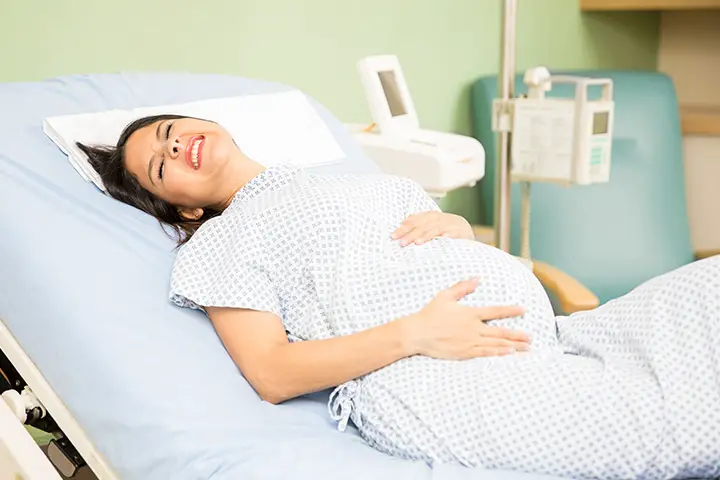Labour is a natural and awe-inspiring process that heralds the arrival of a precious new life. It is a unique journey for each individual, marked by an array of physical and emotional sensations. One of the most notable aspects of labour is the presence of pain, which is often described as intense and overwhelming. But have you ever wondered how pain is experienced during labour? What are the pathways through which these sensations travel within the body? Understanding the pathways of Labour Pain provides insights into the physiological processes at play. It empowers expectant parents and healthcare professionals to better manage and support women during this significant period.
In this blog, we will plunge into the intricate pain pathways that underlie the remarkable phenomenon of labour, exploring the science behind the sensations and shedding light on the body’s incredible ability to bring forth new life.
Painful Blessings & Sacred Struggles: The Transformative Path of Labour
The experience of labour is a multifaceted and subjective journey, influenced by various factors that contribute to its uniqueness for each woman. Labour pain ranks high on the pain rating scale compared to other painful life experiences. However, intriguingly, the memory of this pain tends to be fleeting.
Furthermore, the pattern of labour pain differs between nulliparous (first-time mothers) and multiparous (mothers who have given birth previously) women. It is well-documented that nulliparous women tend to have higher pain scores, particularly if they have not received adequate antenatal education. On the other hand, multiparous women may experience more intense pain during the pelvic phase of labour due to the sudden stimulation of nociceptors around the vaginal vault, vulva, and perineum, as well as the rapid descent of the fetus.
“Labour pain is the threshold between who you are now and who you will become as a mother.”
Pain Perception: From the Uterus to the Brain
Mechanisms of Labour Pain
Labour encompasses the active process of delivering a fetus and is characterized by regular and painful uterine contractions that progressively increase in frequency and intensity.
Labour pain comprises two distinct components: visceral and somatic, with well-documented anatomical pathways. The cervix plays a central role in both the first and second stages of labour.
Visceral Pain
Visceral labour pain occurs during the early first stage and the second stage of childbirth. With each uterine contraction, pressure is exerted on the cervix, leading to stretching and distension. This, in turn, activates excitatory nociceptive afferents, which innervate the endocervix and lower segment of the uterus.
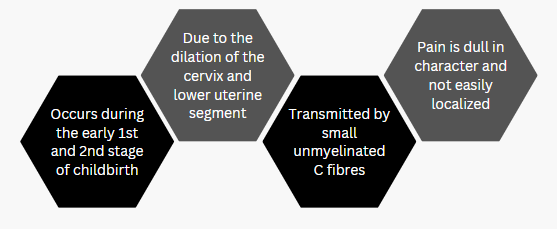
Somatic Pain
Somatic pain complements the visceral pain described above, occurring in the late first stage of labour and continuing into the second stage. It arises from afferents that innervate the vaginal surface of the cervix, perineum, and vagina. Somatic pain arises due to stretching, distension, ischemia, and potential injury such as tearing or iatrogenic causes affecting the pelvic floor, perineum, and vagina. Somatic pain is particularly pronounced during the descent of the fetus when the uterus contracts rhythmically and vigorously.
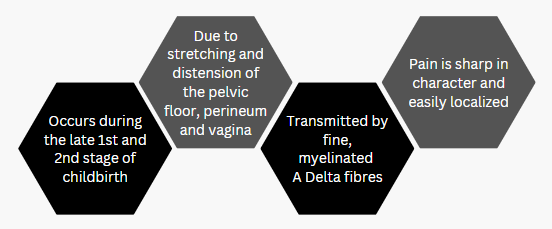
The intensity of labour pain escalates as cervical dilatation increases, displaying a strong correlation with the intensity, duration, and frequency of uterine contractions.
Pathways of Labour Pain
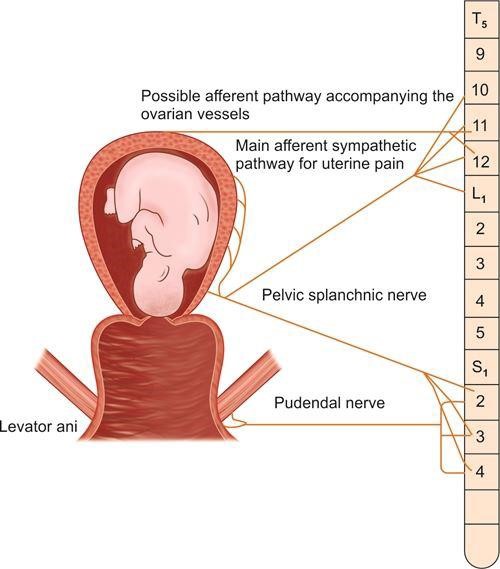
Visceral Pain
Visceral pain during labour is carried by small unmyelinated ‘C’ fibres that travel alongside sympathetic fibres through various nerve plexuses, including the uterine, cervical, and hypogastric plexuses. These pain fibres from the sympathetic chain enter the white rami and communicate associated with T10 to L1 spinal nerves, synapsing in the dorsal horn of the spinal cord. Some fibres cross over at the dorsal horn, resulting in widespread and poorly localised pain. Chemical mediators like bradykinins, leukotrienes, prostaglandins, serotonin, substance P, and lactic acid contribute to the visceral pain experience.
Early labour pain is often called the T10-T12 dermatomes, leading to sensations in the lower abdomen, sacrum, and back. This pain is typically dull in character and may not always respond effectively to opioid drugs, as the response depends on the route of administration.
Somatic Pain
Somatic pain, in contrast, is carried by fine, myelinated ‘A delta’ fibres, which rapidly transmit signals. It is primarily transmitted through the pudendal nerves, perineal branches of the posterior cutaneous nerve of the thigh, and somatic fibres from the cutaneous branches of the ilioinguinal and genitofemoral nerves. These fibres carry afferent signals to the S2-S4 and L1-L2 nerve roots. Somatic pain becomes more pronounced as delivery approaches, characterized by sharp sensations that are easily localized to the vagina, rectum, and perineum. Compared to visceral pain, somatic pain demonstrates higher resistance to opioid drugs.
Both visceral and somatic pain signals, along with other nerve impulses, converge at the dorsal horn cells of the spinal cord, where they are processed and subsequently transmitted to the brain via the spinothalamic tract. This transmission to the hypothalamic and limbic systems contributes to the emotional and autonomic responses associated with pain during labour.
Harnessing ELLE TENS for Labour Pain Management
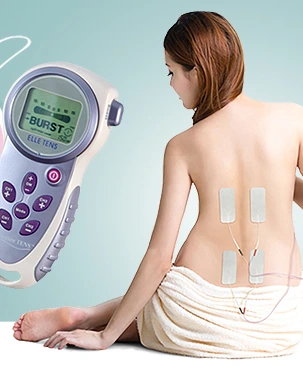
The ELLE TENS device is specifically designed to address the pain experienced during labour by targeting the pain pathways involved in childbirth. Understanding these pain pathways is essential to comprehend how ELLE TENS works to provide pain relief.
During labour, the body undergoes various physiological changes, and pain signals are transmitted through specific nerve pathways. The ELLE TENS utilizes the principles of Transcutaneous Electrical Nerve Stimulation (TENS) to interfere with the transmission of these pain signals and provide relief. It works on the gate control theory of pain, which suggests that the brain can only process a limited amount of information at a time. By stimulating non-painful nerve fibres, it can effectively “close the gate” to the transmission of pain signals, reducing the overall perception of pain, which in turn triggers the release of endorphins, the body’s natural pain-relieving chemicals.
By specifically targeting the pain pathways involved in labour, ELLE TENS provides a non-invasive and drug-free method for managing pain during childbirth. It allows women to have more control over their pain relief experience, as they can adjust the intensity and frequency of the electrical impulses to suit their comfort level. Additionally, the ELLE TENS is portable, enabling women to move and change positions during labour while still receiving pain relief.
“Discover the serenity of labour with ELLE TENS, the science of pain relief in your hands.”

